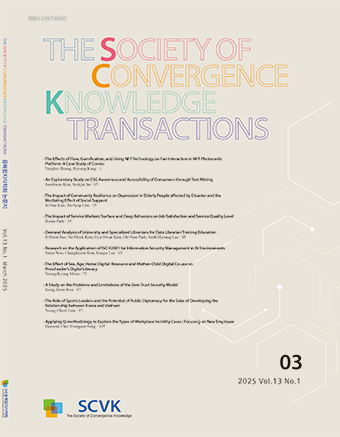Research Article
Abstract
References
Information
4차 산업시대에서 창의적이고 전문성 있는 간호인재 양성을 위해 미래지향적인 교육프로그램이 필요한 상황에서 본 연구는 디자인씽킹 기반 간호학 학습프로그램이 간호대학생의 비판적 사고성향, 일상적 창의력에 미치는 효과를 검증하기 위해 수행되었다. 2020년 5월~7월까지 G광역시 일개 대학의 간호학과 4학년 59명에게 디자인씽킹 기반 학습프로그램을 2주간 총 4회(1회당 40~50분) 적용하였다. 수집된 자료를 기술통계, paired t-test로 분석한 결과 디자인씽킹 기반 간호학 학습프로그램을 경험한 학생들의 비판적 사고능력(t=-6.65, p=.000)과 일상적 창의력(t=-2.17, p=.037)은 향상되었으며 이는 통계적으로 유의하였다. 디자인씽킹 기반 간호학 학습프로그램이 간호대학생의 비판적 사고능력과 창의력을 향상시키기 데 매우 유용하므로 간호교육현장에서 적극 활용되기를 기대한다.
In the era of the Fourth Industrial Revolution, future-oriented educational programs are needed to foster creative and professional nursing talent. This study was done to verify the effect of Design Thinking-based nursing learning program on nursing students’ critical thinking, everyday creativity. Data were collected from May to July 2020, with 59 fourth grade of nursing students at one university in G Metropolitan City. Design Thinking-based nursing learning program was applied D-school’s five stage process that composed of empathize, define, ideate, prototype and test. this program was conducted total 4 times in 2 weeks, each session lasted 40~50 minutes. The collected data were analyzed as descriptive statistics and paired t-test with SPSS 20.0 program. After applying the Design Thinking-based nursing learning program, critical thinking(t=-6.65, p=.000) and everyday creativity(t=-2.17, p=.037) increased which was statistically significant. Based on the above results, the design thinking-based nursing learning program is very useful in improving the critical thinking and creativity of nursing students, so it is expected that it will be actively utilized in the educational field.
- 한국정보통신기술협회, TTA 정보통신용어사전, http://terms.tta.or.kr/dictionary/dictionaryView.do?word_seq =100949-17
- 최연구, 4차 산업혁명의 빛과 그림자, 교육부-정책-초점 4차 산업혁명, https://happyedu.moe.go.kr/happy/bbs /selectHappyArticle.do?bbsId=BBSMSTR_000000000281&nttId=8894
- 안종배, "4차 산업혁명에서의 교육 패러다임의 변화", 미디어와 교육, 7, 1, pp. 21-34, 2017.https://doi.org/10.18237/KDGW.2016.34.4.209
- 박춘자, "한국 간호교육의 실제와 문제점-전문대학 교육과정-", 간호교육학회지, 1, 1, pp. 24-31, 1995.
- 권영은, 간호대학 졸업예정자의 임상실습 만족도 영향요인, 한국간호교육학회지, 24, 1, pp. 80-88, 2018.
- 이정열, 이주명, "디자인사고의 의미 비교", 한국디자인학회 국제학술대회 논문집, pp. 62-63, 2010.
- R. M. Muuller, K. Thoringk, "Design thinking vs learn startup: a comparison of two user-driven innovation strategies", International Design Management Research Conference, pp. 151-161, 2012.
- 우영진 박병주, 이현진, 최미숙, 디자인씽킹 수업, 아이스크림미디어, 2018.
- F. Cassim, "Hands on, hearts on, minds on: design thinking within an education context", Intern ational Journal of Art & Design Education, 32, 2, pp. 190-202, 2013.https://doi.org/10.1111/j.1476-8070.2013.01752.x
- M. Trowbridge, D Chen, A. Gregor, "Teaching design thinking to medical students", Medical educa tion, 52, pp. 1180-1209, 2018.https://doi.org/10.1111/medu.13699PMid:30345675
- 최정아, "중등 예비미술교사이 디자인교육을 위한 디자인 사고 프로세스 적용 가능성 연구", 학습자중심교과교육연구, 16, 12, pp. 1357-1379, 2016. 7. 강명주, 정경희, 조정아, "간호학 임상실습에서 디자인씽킹 기반 팀 프로젝트 학습 설계 및 적용효과", 한국콘텐츠학회논문지, 19, 3, pp. 336-348, 2109.
- 이응규, "경영학 교육에서의 디자인사고 도입 방안사례분석", 인터넷 전자상거래연구, 17, 1, pp. 117~136, 2017.
- 강명주, 정경희, 조정아, "간호학 임상실습에서 디자인씽킹 기반 팀 프로젝트 학습 설계 및 적용 효과", 한국콘텐츠학회논문지, 19, 3, pp. 336-348, 2109.
- 한상미, "디자인씽킹 기반 팀 프로젝트가 간호대학생의 공감, 창의적 성향에 미치는 효과", 인문사회21, 11, 1, pp. 1645-1658, 2020.https://doi.org/10.22143/HSS21.11.1.120
- R. L. Martin, "Design Thinking: 이건식 역", 웅진윙스, 2010.
- H. A. Simon, "The Sciences of the Artificial", MIT Press, 1996.
- 김자인, "디스쿨(d.School)의 디자인사고 교육", 디지털디자인학연구, 15, 4, pp. 97-108, 2015.
- 김정아, 오인균, "디자인씽킹을 활용한 디자인 프로세스 방법론 연구", Journal of Integrated Design Research, 15, 3, pp. 9-18, 2016.https://doi.org/10.21195/jidr.2016.15.3.001
- 디자인씽킹 플레이북, "팀을 구성하려면 간학제와 다학제 중 어떤 것이 좋을까?", https://m.post.naver.com /viewer/postView.nhn?volumeNo=17323314&memberNo=34865381&vType=VERTICAL
- 이도현, "집단 창의성 교육을 위한 방안으로서 과학 교육에 디자인적 사고를 도입하기 위한 핵심 역량 탐색 및 프로세스 개발 연구", 박사학위논문, 한국교원대학교, 2015.
- IDEO, "Design Thinking Toolkit for Educator", Yonsei University HCID Lab 역, 2014.
- 유예은, "디자인씽킹 프로세스 기반의 메이커교육 프로그램 개발 및 적용-감성지능의 효과를 중심으로-", 석사학위논문, 경희대학교, 2018.
- 윤진, "비판적 사고성향 측정도구 개발: 간호학을 중심으로", 박사학위논문, 가톨릭대학교, 2004.
- 정은이, "일상적 창의성과 개별성-관계성 및 심리-사회적 적응의 관계", 박사학위논문, 고려대학교, 2002.
- 지예림, "사례기반학습이 과제성취도와 학습만족도에 미치는 영향", 석사학위논문, 안동대학교, 2014.
- 이종만, "디자인씽킹에 기반한 「교과 논리 및 논술」수업 사례연구: 예비유아교사의 비판적 사고와 창의적 태도를 중심으로", 학습자중심교과교육학회지, 20, 13, pp. 647-673, 2020.
- 고은희, 나건, "기업가 정신교육에 있어서 디자인씽킹의 효과성 검증 : 인문학계열 대학생을 중심으로", 한국디자인포럼, 64, 3, pp. 95-104, 2019.https://doi.org/10.21326/ksdt.2019.24.3.009
- B. Badwan, R. Bothara, Mieke latijnhouwers, A, Sithies, John Sandars, "The importance of design thinking in medical education", Medical Teacher, 40, 4, pp.425-426, 2018.https://doi.org/10.1080/0142159X.2017.1399203PMid:29125007
- 정여원, 민혜영, "개념지도를 활용한 팀 기반 학습이 간호대학생의 비판적 사고성향 및 메타인지에 미치는 영향", 한국간호교육학회지, 25, 3, pp. 277-288, 2019.
- 김은정, "대학 수업에서 팀 기반 학습 적용 효과에 대한 메타분석", 학습자중심교과교육연구, 17, 2, pp. 721-743. 2017.
- 이정은, 양승희, "간호학 분야 학습자 중심수업의 효과에 대한 메타분석", 아시아교육연구, 19, 4, pp. 1049-1077, 2018.https://doi.org/10.15753/aje.2018.12.19.4.1049
- 주영주, 강아란, 임유진, "국내 사이버대학생의 학습만족도에 영향을 미치는 관련변인에 대한 메타분석", 평생학습사회, 12, 2, pp. 145-170, 2016.https://doi.org/10.26857/JLLS.2016.05.12.2.145
- Publisher :The Society of Convergence Knowledge
- Publisher(Ko) :융복합지식학회
- Journal Title :The Society of Convergence Knowledge Transactions
- Journal Title(Ko) :융복합지식학회논문지
- Volume : 8
- No :4
- Pages :1-9
- DOI :https://doi.org/10.22716/sckt.2020.8.4.030




 The Society of Convergence Knowledge Transactions
The Society of Convergence Knowledge Transactions







